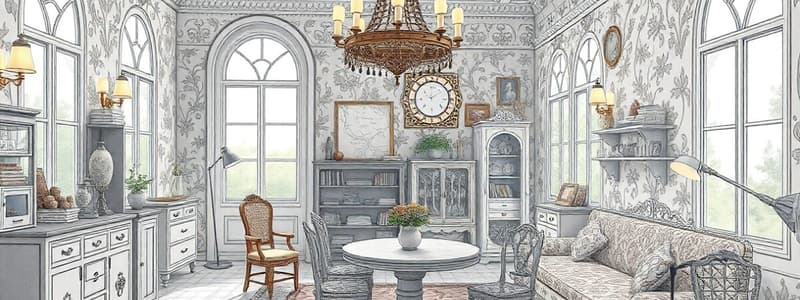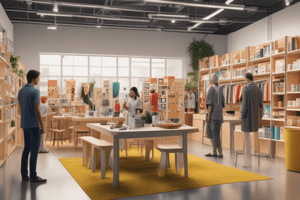Podcast
Questions and Answers
Which of the following aspects of IKEA's business model contributes to its competitive pricing?
Which of the following aspects of IKEA's business model contributes to its competitive pricing?
- The integrated shopping experience with showrooms, pick-up style, and restaurant.
- The mass production of furniture components based on forecasted demand. (correct)
- The use of unique Scandinavian design.
- The customer's responsibility for assembling furniture.
Which aspect of IKEA's strategy is NOT directly related to its "order winner" proposition?
Which aspect of IKEA's strategy is NOT directly related to its "order winner" proposition?
- The integration of a shopping experience with showrooms, pick-up style, and restaurants.
- Availability and convenience of stores and delivery options.
- Affordability achieved through DIY assembly. (correct)
- Unique Scandinavian design and aesthetics.
What is the primary strategy employed by IKEA in terms of production and inventory management?
What is the primary strategy employed by IKEA in terms of production and inventory management?
- Just-in-time, where materials are procured and production occurs only when needed for the customer order.
- Assemble-to-order, where pre-made components are assembled only after a customer order.
- Make-to-stock, where products are mass-produced and held in inventory for immediate purchase. (correct)
- Make-to-order, where products are manufactured only after a customer order is received.
Which of the following customer responsibilities is NOT explicitly mentioned in the provided text, but can be inferred as a component of IKEA's business model?
Which of the following customer responsibilities is NOT explicitly mentioned in the provided text, but can be inferred as a component of IKEA's business model?
Which of the following aspects contributes to IKEA's "integrated shopping experience"?
Which of the following aspects contributes to IKEA's "integrated shopping experience"?
What is a significant supply chain challenge IKEA might encounter when implementing a buy-back program?
What is a significant supply chain challenge IKEA might encounter when implementing a buy-back program?
What potential challenge related to inventory management does IKEA face when implementing a buy-back program?
What potential challenge related to inventory management does IKEA face when implementing a buy-back program?
Which of the following is a potential drawback of IKEA's buy-back program in terms of its existing customer experience?
Which of the following is a potential drawback of IKEA's buy-back program in terms of its existing customer experience?
What aspect of IKEA's existing customer experience might be negatively impacted by the buy-back program?
What aspect of IKEA's existing customer experience might be negatively impacted by the buy-back program?
What potential challenge does IKEA face in terms of product quality control with its buy-back program?
What potential challenge does IKEA face in terms of product quality control with its buy-back program?
What concern is raised regarding the potential for a uniform global approach to product safety checks?
What concern is raised regarding the potential for a uniform global approach to product safety checks?
What specific aspect of product safety is potentially compromised by customer assembly?
What specific aspect of product safety is potentially compromised by customer assembly?
What limitation of IKEA's automated durability tests is highlighted in the text?
What limitation of IKEA's automated durability tests is highlighted in the text?
What is a key benefit of standardized components in the described business model?
What is a key benefit of standardized components in the described business model?
Which of the following is NOT a potential drawback of the described model for customers?
Which of the following is NOT a potential drawback of the described model for customers?
Which of the following is a potential consequence of the described model's emphasis on standardization?
Which of the following is a potential consequence of the described model's emphasis on standardization?
One key element of the business model described is:
One key element of the business model described is:
What is a potential challenge that this business model faces in a rapidly changing market?
What is a potential challenge that this business model faces in a rapidly changing market?
Why is the 'do-it-yourself' aspect of this model a potential concern?
Why is the 'do-it-yourself' aspect of this model a potential concern?
Which of the following business models poses a direct competitive threat to the one described in the text?
Which of the following business models poses a direct competitive threat to the one described in the text?
What is a key aspect of the described business model that contributes to achieving a consistent brand experience?
What is a key aspect of the described business model that contributes to achieving a consistent brand experience?
What is the primary reason for IKEA's in-store sales success?
What is the primary reason for IKEA's in-store sales success?
Which of these features is NOT a primary reason for customers to make a long trip to an IKEA store?
Which of these features is NOT a primary reason for customers to make a long trip to an IKEA store?
What is IKEA's primary strategy for increasing its online sales?
What is IKEA's primary strategy for increasing its online sales?
What is the primary goal of IKEA's buy-back program?
What is the primary goal of IKEA's buy-back program?
Which of the following is a limitation of IKEA's buy-back program?
Which of the following is a limitation of IKEA's buy-back program?
How does IKEA's focus on self-service contribute to operational efficiency?
How does IKEA's focus on self-service contribute to operational efficiency?
What is the main challenge IKEA faces with recycling its used products?
What is the main challenge IKEA faces with recycling its used products?
Flashcards
Essential Product Quality (OQ)
Essential Product Quality (OQ)
Baseline standard of quality ensuring durability and handling of normal wear and tear.
Order Winners (OW)
Order Winners (OW)
Unique features that differentiate products, like modern design and integrated shopping experiences.
DIY Assembly Benefits
DIY Assembly Benefits
Reducing costs by having customers assemble their own furniture, making products more affordable.
Make-to-Stock Strategy
Make-to-Stock Strategy
Signup and view all the flashcards
Customer Responsibilities
Customer Responsibilities
Signup and view all the flashcards
Mass production
Mass production
Signup and view all the flashcards
Economies of scale
Economies of scale
Signup and view all the flashcards
Simplified supply chain
Simplified supply chain
Signup and view all the flashcards
Limited customization
Limited customization
Signup and view all the flashcards
Competition from specialized retailers
Competition from specialized retailers
Signup and view all the flashcards
Customer assembly
Customer assembly
Signup and view all the flashcards
Predictable demand
Predictable demand
Signup and view all the flashcards
Risk of inflexibility
Risk of inflexibility
Signup and view all the flashcards
Entrance and showroom
Entrance and showroom
Signup and view all the flashcards
Market hall
Market hall
Signup and view all the flashcards
Self-serve warehouse
Self-serve warehouse
Signup and view all the flashcards
Checkout process
Checkout process
Signup and view all the flashcards
Customer experience
Customer experience
Signup and view all the flashcards
Digital visualization
Digital visualization
Signup and view all the flashcards
Sustainability initiatives
Sustainability initiatives
Signup and view all the flashcards
Feedback for improvement
Feedback for improvement
Signup and view all the flashcards
Reverse Logistics
Reverse Logistics
Signup and view all the flashcards
Buy-back Program
Buy-back Program
Signup and view all the flashcards
Supply Chain Challenges
Supply Chain Challenges
Signup and view all the flashcards
Inventory Management
Inventory Management
Signup and view all the flashcards
Quality Control
Quality Control
Signup and view all the flashcards
Durability Testing
Durability Testing
Signup and view all the flashcards
Customer Assembly Safety
Customer Assembly Safety
Signup and view all the flashcards
Separate Inventory Channels
Separate Inventory Channels
Signup and view all the flashcards
Study Notes
IKEA Product Quality and Design
- OQ (essential product quality): Baseline standard of quality, handles normal wear and tear
- Competitive pricing
- Reasonable availability and convenience (stores and pick-up/delivery options)
- Wide range of home furnishings
IKEA Unique Design and Shopping Experience
- OW (unique design): Modern Scandinavian design, aesthetics
- Affordability: DIY assembly reduces costs
- Integrated shopping experience: showrooms, pick-up service, restaurant
IKEA's Business Model and Customer Participation
- IKEA's business model emphasizes customer participation
- Customers measure spaces, select furniture, pick up items, assemble furniture, and ask questions
- Various levels of customer participation in service delivery (low, moderate, high)
IKEA Inventory Management Strategies
- Make-to-stock (MTS) strategy: Mass-producing components based on forecasted demand
- Mass production of standardized components
- Pre-packaged inventory in self-service warehouses
- Forecast-driven inventory and supply chain
- End-user assembly (not in store)
Pros and Cons of IKEA Standardization
- Economies of scale, low production costs, efficient supply chain management, reliable demand forecasting, and consistent quality and brand experience
- Limitations in customization, possible mismatches with niche demands, and overlooking local preferences
IKEA Facility Layout
- Store layout strategically guides customers through areas like the entrance, showrooms, market hall, and self-serve warehouse
- Showrooms and cafés; market hall (impulse buys); self-serve warehouses (flat-packed furniture)
IKEA Brick-and-Mortar vs Online Sales
- In-store sales are significantly higher than online sales due to immersive experiences, physical product testing, self-service convenience, and familiar brand experience
- Ways to increase online sales include VR/AR visualization, more digital inspiration, collaborations with interior designers, and better delivery experience
IKEA and Circular Economy
- Focus on sustainability: product lifecycle, promoting recycling, and facilitating refurbishment
- Wood is primary material; recycling can create quality declines, and not all items are recyclable
- Challenges with reverse logistics, collection points, refurbishment process
Quality Control at IKEA
- Standardized tests for ensuring product safety, but may not account for extreme use case scenarios
- Assembly completion by the customer also contributes to product safety and durability assessment.
- Automated tests may not precisely measure the natural actions of consumers using IKEA products
Studying That Suits You
Use AI to generate personalized quizzes and flashcards to suit your learning preferences.




